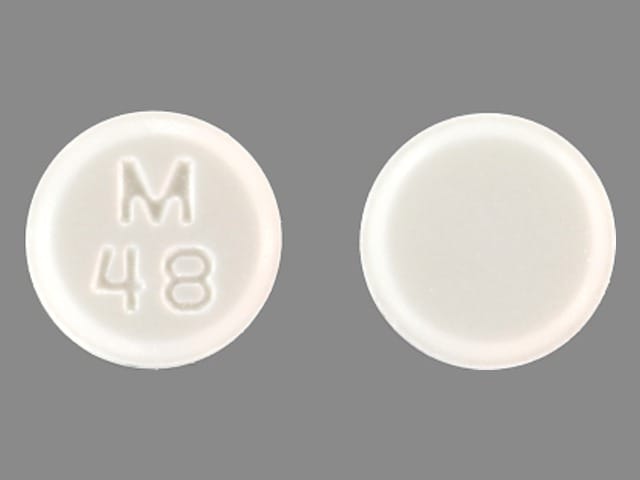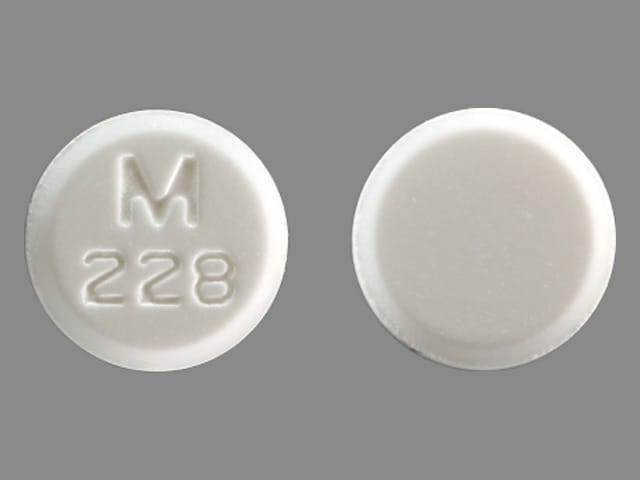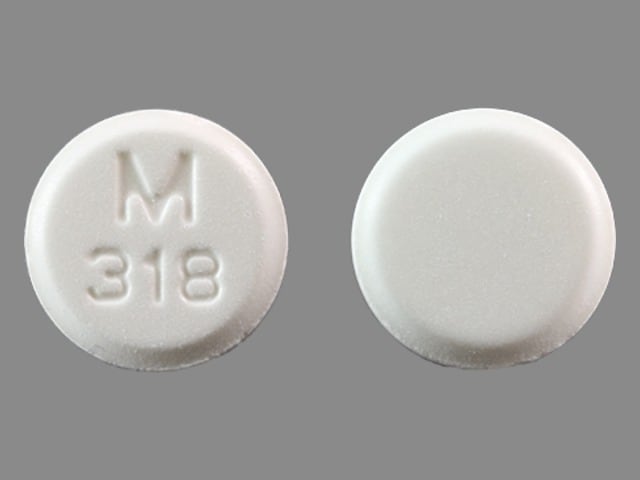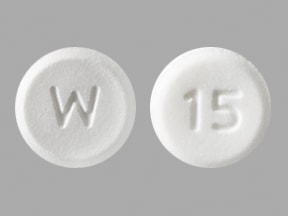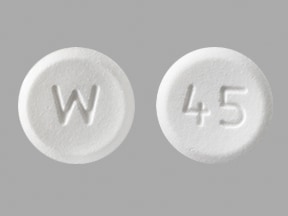Boxed Warning
Congestive heart failure:
Thiazolidinediones, including pioglitazone, can cause or exacerbate congestive heart failure (CHF) in some patients. After initiation of pioglitazone, and after dose increases, observe patients carefully for signs and symptoms of heart failure (including excessive, rapid weight gain, dyspnea, and/or edema). If these signs and symptoms develop, manage the heart failure according to the current standards of care. Furthermore, discontinuation or dose reduction of pioglitazone must be considered.
Pioglitazone is not recommended in patients with symptomatic heart failure. Initiation of pioglitazone in patients with established New York Heart Association (NYHA) class III or IV heart failure is contraindicated.
Dosage Forms
Excipient information presented when available (limited, particularly for generics); consult specific product labeling.
Tablet, Oral:
Actos: 15 mg, 30 mg, 45 mg
Generic: 15 mg, 30 mg, 45 mg
Pharmacology
Mechanism of Action
Thiazolidinedione antidiabetic agent that lowers blood glucose by improving target cell response to insulin, without increasing pancreatic insulin secretion. It has a mechanism of action that is dependent on the presence of insulin for activity. Pioglitazone is a potent and selective agonist for peroxisome proliferator-activated receptor-gamma (PPARgamma). Activation of nuclear PPARgamma receptors influences the production of a number of gene products involved in glucose and lipid metabolism. PPARgamma is abundant in the cells within the renal collecting tubules; fluid retention results from stimulation by thiazolidinediones which increases sodium reabsorption.
Pharmacokinetics/Pharmacodynamics
Distribution
Vd (apparent): 0.63 ± 0.41 L/kg
Metabolism
Hepatic (99%) via CYP2C8 and 3A4 to active and inactive metabolites; M-III and M-IV are major circulating active metabolites
Excretion
Urine (15% to 30%) and feces as metabolites
Onset of Action
Delayed; Peak effect: Glucose control: Several weeks
Time to Peak
~2 hours; delayed with food
Half-Life Elimination
Parent drug: 3 to 7 hours; M-III and M-IV metabolites: 16 to 24 hours
Protein Binding
Pioglitazone >99% and active metabolites >98%; primarily to albumin
Use: Labeled Indications
Diabetes mellitus, type 2: As an adjunct to diet and exercise, to improve glycemic control in adults with type 2 diabetes mellitus
Contraindications
Hypersensitivity to pioglitazone or any component of the formulation; NYHA Class III/IV heart failure (initiation of therapy)
Canadian labeling: Additional contraindications (not is U.S. labeling): Any stage of heart failure (eg, NYHA Class I, II, III, IV); serious hepatic impairment; active bladder cancer; history of bladder cancer; uninvestigated macroscopic hematuria; pregnancy
Dosage and Administration
Dosing: Adult
Diabetes mellitus, type 2: Oral:
Initial: 15 to 30 mg once daily.
Patients with asymptomatic NYHA class I or II heart failure (HF): Initiate cautiously with 15 mg once daily. Note: Not recommended in patients with symptomatic HF and contraindicated with stage III or IV HF; the ADA generally recommends avoiding thiazolidinediones in the setting of HF (ADA 2019).
Dosage titration: Based on HbA1c, the dosage may be increased in 15 mg increments with careful monitoring of adverse effects (eg, weight gain, edema, signs/symptoms of HF) up to a maximum of 45 mg once daily; consider limiting dose to ≤30 mg/day if worsening HF is a concern (AACE/ACE [Garber 2019]).
Dosage adjustment for hypoglycemia with combination therapy:
With an insulin secretagogue (eg, sulfonylurea): Decrease the insulin secretagogue dose.
With insulin: Decrease insulin dose by 10% to 25%; individualize further adjustments per glycemic response.
Dosage adjustment with strong CYP2C8 inhibitors (eg, gemfibrozil): Maximum recommended dose: 15 mg once daily.
Dosing: Geriatric
Refer to adult dosing.
Administration
Oral: May be administered without regard to meals
Dietary Considerations
Individualized medical nutrition therapy (MNT) is an integral part of therapy
Storage
Store at 25°C (77°F); excursions permitted to 15°C to 30°C (59°F to 86°F). Protect from light, moisture, and humidity.
Pioglitazone Images
Drug Interactions
Alpha-Lipoic Acid: May enhance the hypoglycemic effect of Antidiabetic Agents. Monitor therapy
Androgens: May enhance the hypoglycemic effect of Blood Glucose Lowering Agents. Exceptions: Danazol. Monitor therapy
CYP2C8 Inducers (Moderate): May decrease the serum concentration of Pioglitazone. Monitor therapy
CYP2C8 Inhibitors (Moderate): May increase the serum concentration of Pioglitazone. Monitor therapy
CYP2C8 Inhibitors (Strong): May increase the serum concentration of Pioglitazone. Management: Limit the pioglitazone dose to 15 mg daily and monitor for increased pioglitazone toxicities (eg, hypoglycemia) when used in combination with strong CYP2C8 inhibitors. Consider therapy modification
Direct Acting Antiviral Agents (HCV): May enhance the hypoglycemic effect of Antidiabetic Agents. Monitor therapy
Guanethidine: May enhance the hypoglycemic effect of Antidiabetic Agents. Monitor therapy
Hyperglycemia-Associated Agents: May diminish the therapeutic effect of Antidiabetic Agents. Monitor therapy
Hypoglycemia-Associated Agents: Antidiabetic Agents may enhance the hypoglycemic effect of Hypoglycemia-Associated Agents. Monitor therapy
Insulins: Pioglitazone may enhance the adverse/toxic effect of Insulins. Specifically, the risk for hypoglycemia, fluid retention, and heart failure may be increased with this combination. Management: If insulin is combined with pioglitazone, dose reductions should be considered to reduce the risk of hypoglycemia. Monitor patients for fluid retention and signs/symptoms of heart failure. Consider therapy modification
Lumacaftor and Ivacaftor: May decrease the serum concentration of CYP2C8 Substrates (High Risk with Inhibitors or Inducers). Lumacaftor and Ivacaftor may increase the serum concentration of CYP2C8 Substrates (High Risk with Inhibitors or Inducers). Monitor therapy
Maitake: May enhance the hypoglycemic effect of Blood Glucose Lowering Agents. Monitor therapy
Monoamine Oxidase Inhibitors: May enhance the hypoglycemic effect of Blood Glucose Lowering Agents. Monitor therapy
Pegvisomant: May enhance the hypoglycemic effect of Blood Glucose Lowering Agents. Monitor therapy
Pregabalin: May enhance the fluid-retaining effect of Thiazolidinediones. Monitor therapy
Prothionamide: May enhance the hypoglycemic effect of Blood Glucose Lowering Agents. Monitor therapy
Quinolones: May enhance the hypoglycemic effect of Blood Glucose Lowering Agents. Quinolones may diminish the therapeutic effect of Blood Glucose Lowering Agents. Specifically, if an agent is being used to treat diabetes, loss of blood sugar control may occur with quinolone use. Monitor therapy
Ritodrine: May diminish the therapeutic effect of Antidiabetic Agents. Monitor therapy
Salicylates: May enhance the hypoglycemic effect of Blood Glucose Lowering Agents. Monitor therapy
Selective Serotonin Reuptake Inhibitors: May enhance the hypoglycemic effect of Blood Glucose Lowering Agents. Monitor therapy
Sulfonylureas: Thiazolidinediones may enhance the hypoglycemic effect of Sulfonylureas. Management: Consider sulfonylurea dose adjustments in patients taking thiazolidinediones and monitor for hypoglycemia. Consider therapy modification
Thiazide and Thiazide-Like Diuretics: May diminish the therapeutic effect of Antidiabetic Agents. Monitor therapy
Topiramate: May decrease the serum concentration of Pioglitazone. Monitor therapy
Adverse Reactions
Adverse reactions and incidences reported are associated with monotherapy unless otherwise stated.
>10%:
Cardiovascular: Edema (combination trials: ≤27%)
Endocrine and metabolic: Hypoglycemia (combination trials: ≤27%)
Respiratory: Upper respiratory tract infection (13%)
1% to 10%:
Cardiovascular: Cardiac failure (combination trials: ≤8%)
Central nervous system: Headache (9%)
Neuromuscular & skeletal: Bone fracture (females: ≤5%), myalgia (5%)
Respiratory: Sinusitis (6%), pharyngitis (5%)
Frequency not defined:
Endocrine & metabolic: Decreased serum triglycerides, increased HDL-cholesterol, weight gain, weight loss
Hematologic & oncologic: Decreased hematocrit, decreased hemoglobin
<1%, postmarketing, and/or case reports: Bladder carcinoma, blurred vision, decreased visual acuity, dyspnea (associated with weight gain and/or edema), hepatic failure (very rare), hepatitis, increased creatine phosphokinase, increased serum transaminases, macular edema (new-onset or worsening), pulmonary edema, rhabdomyolysis
Warnings/Precautions
Concerns related to adverse effects:
- Bladder cancer: An FDA review concluded that although clinical trial data are inconsistent regarding the risk of bladder cancer in patients exposed to pioglitazone, there is still the potential for an increased risk and package labeling has been updated to reflect this. Avoid use of pioglitazone in patients with active bladder cancer and consider risks versus benefits prior to initiating therapy in patients with a history of bladder cancer.
- Edema: Dose-related edema, including new-onset or exacerbation of existing edema, has been reported; use with caution in patients with edema. Monitor for signs/symptoms of heart failure.
- Fractures: An increased incidence of bone fractures in females treated with pioglitazone has been observed; majority of fractures occurred in the lower limb and distal upper limb. Consider risk of fracture prior to initiation and during use.
- Heart failure/cardiac effects: [US Boxed Warning]: Thiazolidinediones, including pioglitazone, may cause or exacerbate heart failure; closely monitor for signs and symptoms of heart failure (HF) (eg, rapid weight gain, dyspnea, edema), particularly after initiation or dose increases; if HF develops, treat accordingly and consider dose reduction or discontinuation of pioglitazone. Not recommended for use in any patient with symptomatic HF. Initiation of therapy is contraindicated in patients with NYHA class III or IV HF; if used in patients with NYHA class I or II (systolic) HF, initiate at lowest dosage and monitor closely.
- Hematologic effects: May decrease hemoglobin/hematocrit; effects may be related to increased plasma volume.
- Hepatic effects: Hepatic failure, including fatalities, has been reported. Monitor for signs/symptoms of liver injury closely during therapy; discontinuation of therapy may be necessary.
- Hypoglycemia: The risk of hypoglycemia is increased when pioglitazone is combined with insulin or other diabetic medications; dosage adjustment of concomitant hypoglycemic agents may be necessary.
- Macular edema: Has been reported with thiazolidinedione use, including pioglitazone; some patients with macular edema presented with blurred vision or decreased visual acuity, and most had peripheral edema at time of diagnosis. Patients should be seen by an ophthalmologist if any visual symptoms arise during therapy and all diabetic patients should have regular eye exams.
- Weight gain: Dose-related weight gain observed with use; mechanism unknown but likely associated with fluid retention and fat accumulation.
Disease-related concerns:
- Bariatric surgery:
– Altered absorption: Absorption may be altered given the anatomic and transit changes created by gastric bypass and sleeve gastrectomy surgery (Mechanick 2013; Melissas 2013).
– Weight gain: Evaluate risk vs benefit and consider alternative therapy after gastric bypass, sleeve gastrectomy, and gastric banding; weight gain may occur (Apovian 2015).
- Diabetes, type 1: Mechanism requires the presence of insulin; therefore, use in type 1 diabetes or diabetic ketoacidosis is not recommended.
- Hepatic impairment: Due to the possible risk of drug-induced liver injury, serum liver function tests (ALT, AST, alkaline phosphatase, and total bilirubin) should be obtained prior to initiation in all patients. In patients with abnormal hepatic tests, therapy should be initiated with caution. During therapy, if signs/symptoms of liver injury (eg, fatigue, anorexia, jaundice, dark urine, right upper abdominal discomfort) arise, interrupt pioglitazone therapy, obtain liver tests immediately and evaluate alternative etiologies. If an alternative etiology is not identified and serum ALT is >3 × ULN, do not resume therapy. Patients with serum ALT >3 × ULN and serum total bilirubin >2 × ULN are at risk for severe drug-induced liver injury.
Concurrent drug therapy issues:
- Drug-drug interactions: Potentially significant interactions may exist, requiring dose or frequency adjustment, additional monitoring, and/or selection of alternative therapy. Consult drug interactions database for more detailed information.
Monitoring Parameters
Hemoglobin A1c (at least twice yearly in patients who have stable glycemic control and are meeting treatment goals; quarterly in patients not meeting treatment goals or with therapy change [ADA 2019]), serum glucose.
Liver enzymes (ALT, AST, alkaline phosphatase, and total bilirubin) prior to initiation in all patients (with or without liver disease); continue routine periodic monitoring during treatment only in patients with liver disease or suspected liver disease.
Signs and symptoms of fluid retention or heart failure; weight gain; signs/symptoms of bladder cancer (dysuria, macroscopic hematuria, dysuria, urinary urgency); ophthalmic exams
Pregnancy
Pregnancy Considerations
Information related to the use of pioglitazone in pregnancy is limited (Glueck 2003; Ortega-Gonzalez 2005; Ota 2008).
Poorly controlled diabetes during pregnancy can be associated with an increased risk of adverse maternal and fetal outcomes, including diabetic ketoacidosis, preeclampsia, spontaneous abortion, preterm delivery, delivery complications, major birth defects, stillbirth, and macrosomia. To prevent adverse outcomes, prior to conception and throughout pregnancy, maternal blood glucose and HbA1c should be kept as close to target goals as possible but without causing significant hypoglycemia (ADA 2020; Blumer 2013).
Agents other than pioglitazone are currently recommended to treat diabetes mellitus in pregnancy (ADA 2020).
Thiazolidinediones may cause ovulation in anovulatory premenopausal females, increasing the risk of unintended pregnancy. Due to long-term safety concerns associated with their use, thiazolidinediones should be avoided in females of reproductive age (Fauser 2012).
Patient Education
What is this drug used for?
- It is used to lower blood sugar in patients with high blood sugar (diabetes).
Frequently reported side effects of this drug
- Headache
- Common cold symptoms
- Sinus pain
- Sore throat
- Muscle pain
- Passing gas
Other side effects of this drug: Talk with your doctor right away if you have any of these signs of:
- Heart problems like cough or shortness of breath that is new or worse, swelling of the ankles or legs, abnormal heartbeat, weight gain of more than five pounds in 24 hours, dizziness, or passing out.
- Bone pain
- Severe loss of strength and energy
- Chest pain
- Vision changes
- Painful urination
- Blood in the urine
- Passing a lot of urine
- Low blood sugar like dizziness, headache, fatigue, feeling weak, shaking, fast heartbeat, confusion, increased hunger, or sweating.
- Liver problems like dark urine, fatigue, lack of appetite, nausea, abdominal pain, light-colored stools, vomiting, or yellow skin.
- Signs of a significant reaction like wheezing; chest tightness; fever; itching; bad cough; blue skin color; seizures; or swelling of face, lips, tongue, or throat.
Note: This is not a comprehensive list of all side effects. Talk to your doctor if you have questions.
Consumer Information Use and Disclaimer: This information should not be used to decide whether or not to take this medicine or any other medicine. Only the healthcare provider has the knowledge and training to decide which medicines are right for a specific patient. This information does not endorse any medicine as safe, effective, or approved for treating any patient or health condition. This is only a brief summary of general information about this medicine. It does NOT include all information about the possible uses, directions, warnings, precautions, interactions, adverse effects, or risks that may apply to this medicine. This information is not specific medical advice and does not replace information you receive from the healthcare provider. You must talk with the healthcare provider for complete information about the risks and benefits of using this medicine.
